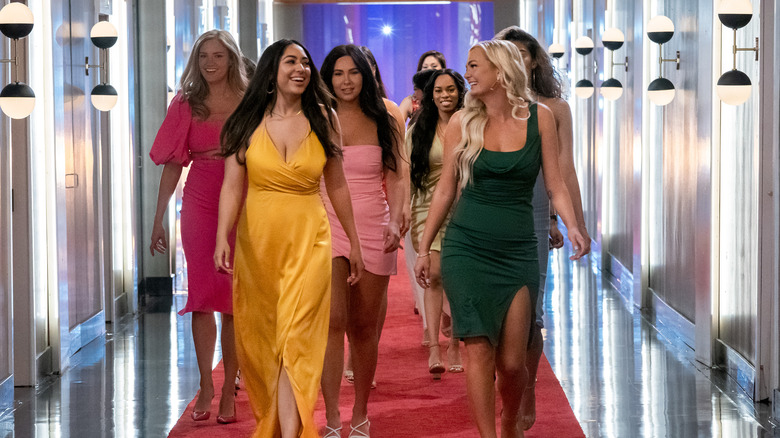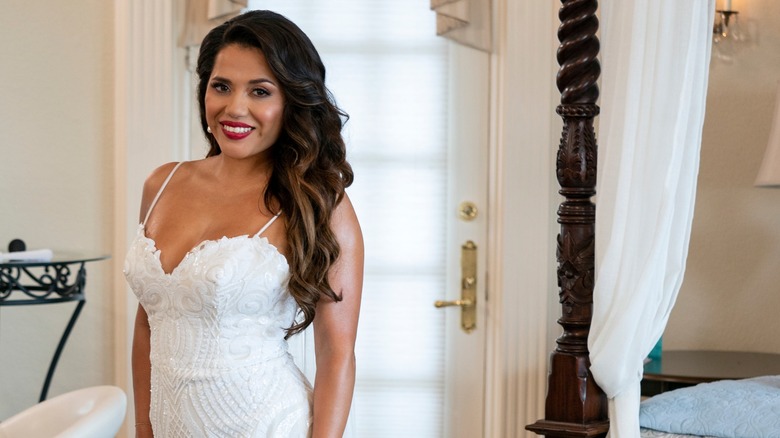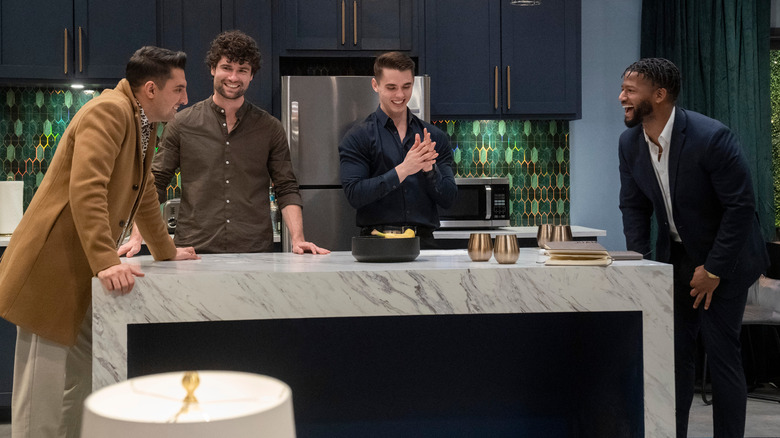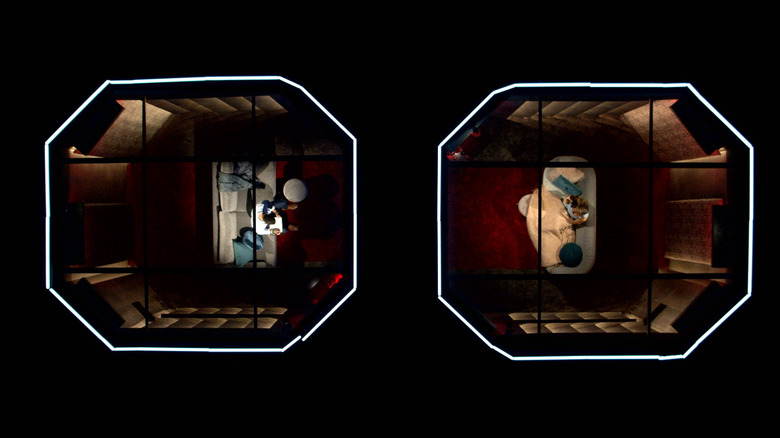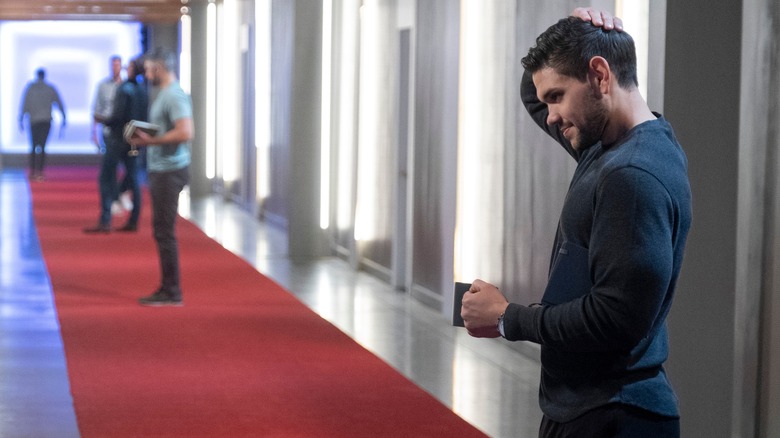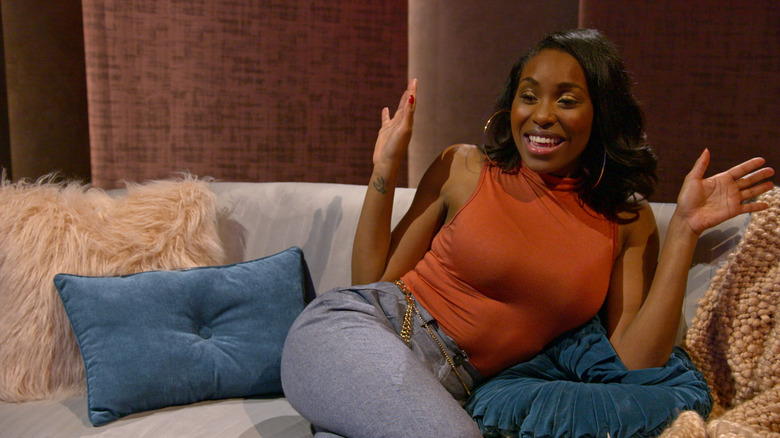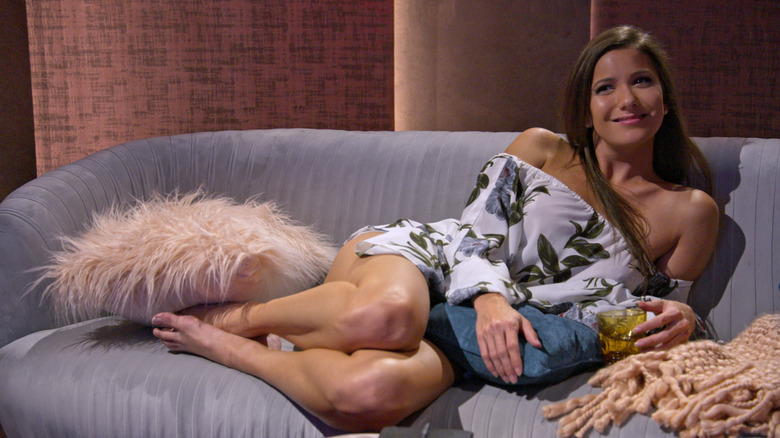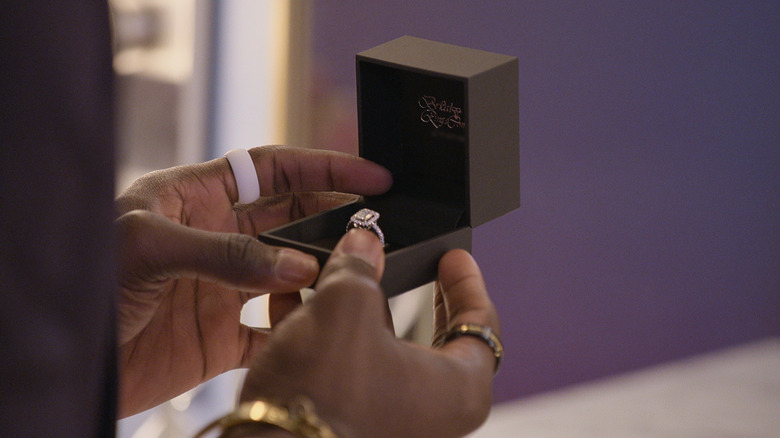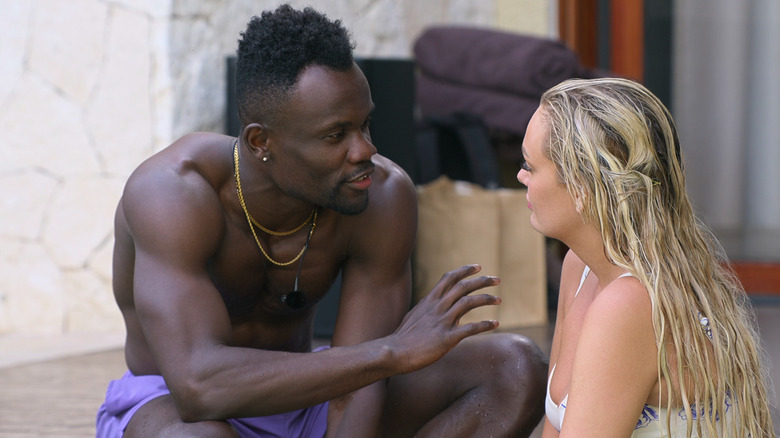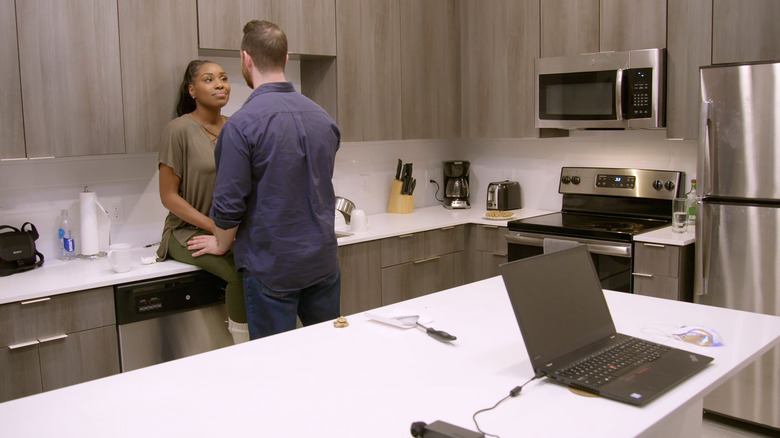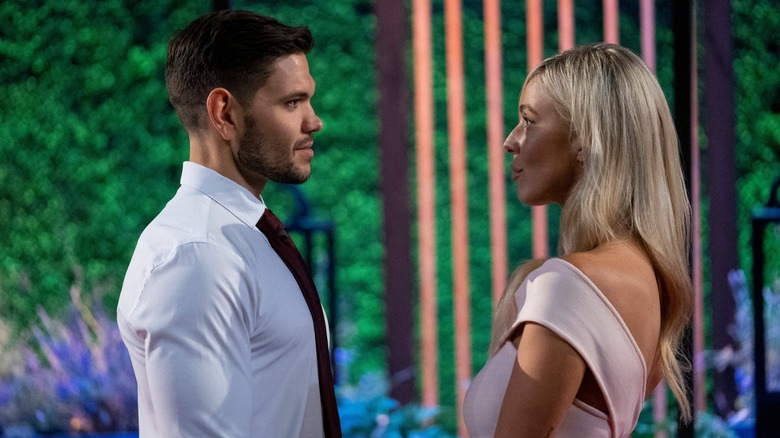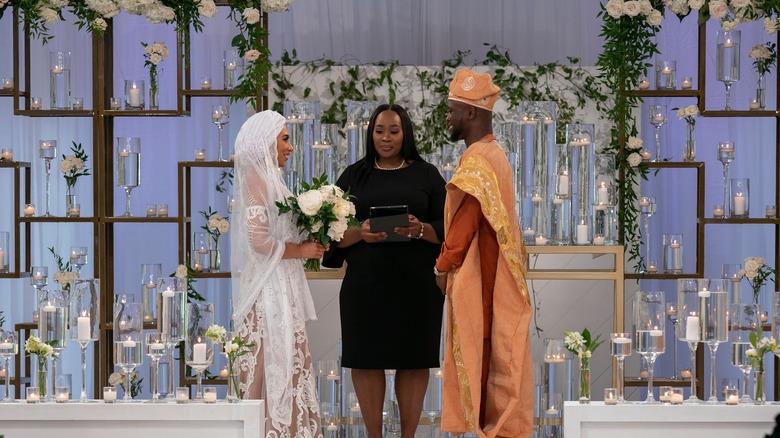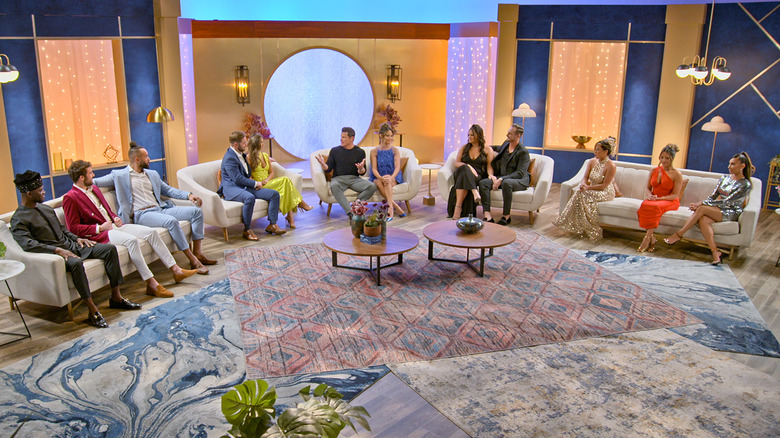Weird Rules Love Is Blind Contestants Are Forced To Follow
Since the first season aired in 2020, Netflix's "Love Is Blind" has been one of our favorite dating shows. Hosted by real-life couple Nick and Vanessa Lachey and produced by the company behind "Married at First Sight," the show has an unusual premise. Instead of pairing well-matched couples at the beginning of the show, producers let singles mix and mingle until they find a connection — but there's a catch. Couples can't see each other until they've already become engaged.
After the question is popped, couples meet and spend a few weeks living as an engaged couple. They head out on a honeymoon, live together, meet each other's friends and families, plan a wedding, and, if all goes well, walk down the aisle and tie the knot. Even though falling in love with someone you've never seen face-to-face may sound pretty wild, the premise has proven somewhat successful. As of this writing, four couples from "Love Is Blind" are still together.
While you already know the basic rules of "Love Is Blind," there are a few surprising guidelines that contestants must also follow.
You have to answer a whole lot of questions, proving you're committed to the experiment
Let's face it — there are some dating shows out there that seem to be more focused on creating drama than helping singles find love. However, on "Love Is Blind," producers are adamant that love really is the main objective. While you might assume that the casting team would seek out the most charismatic, dramatic personalities, they are actually looking for people who really want to find a good connection above all else. In other words, contestants have to be committed to the experiment.
As the show's creator, Chris Coelen, told The Hollywood Reporter, "It's an experiment first, and it's a TV show documenting that experiment second." Coelen explained that the team is very careful about choosing contestants who are willing to give it their all. "The intention is that you invite into the pods people who go through a pretty rigorous process to be chosen, and they have a stated intention of being serious about finding someone," he said.
In fact, the casting team makes every contestant go through a lengthy 73-question questionnaire to make sure people are serious. As Season 3's Nancy Rodriguez told BuzzFeed, "Had I not even been [cast] at the end, just going through those questionnaires and interviews was really powerful for me because it helped me to better understand why I was doing this."
Contestants are essentially quarantined for 10 days
Even if you've only caught a few episodes of "Love Is Blind," you'll know that the first few episodes center around the "pods." Essentially, pods are rooms where couples can talk without seeing each other. The singles spend 10 days dating in the pods before those who get engaged head off for the honeymoon portion of the show. When the singles aren't in the pods, they are confined to their living quarters (women with women; men with men) — and they don't leave for 10 days.
In Season 1, the living quarters were trailers with "correctional facility beds," first-season contestant Kenny Barnes told Refinery29. "The design was to just strip us down from our comfort level." Yikes, it certainly sounds like the living conditions were not exactly ideal! However, the contestants didn't exactly spend much time sleeping. "The first four days we filmed on average I'd say 18 to 20 hours," Kenny explained.
Show creator Chris Coelen explained to Netflix that they chose hotel rooms for later seasons. To ensure contestants avoid sneaking peeks at each other, they are escorted to and from the pods.
No seeing or touching in the pods
We all know the singles on "Love Is Blind" aren't allowed to see each other. That is, after all, the premise of the show. However, the no-touching aspect doesn't get as much attention. There is no way for the couples to physically interact within the pods. These are really the only two hard and fast rules of the show — no seeing and no touching – Chris Coelen confirmed to AV Club. "But other than that, they could do anything they wanted to do — we encouraged them to be creative."
The dating pods are set up so that singles have no idea what the others look like. The pods contain a large adjoining illuminated panel through which the contestants get to know each other. "You can't see anything but a very vague silhouette of what's happening on the other side," co-host Nick Lachey explained to Netflix. "You're truly flying blind."
As Vanessa Lachey told CBS News, this is done to encourage stronger emotional connections. "When you take one of the senses away, the others are heightened. I think you feel more, you listen more, you're forced to listen, 'cause you can't watch them and get distracted by them and by their, whether it's a wonky eyebrow, or if he's, like, checking out cleavage or whatever it is, that's all taken away."
Couples have to start off dating everyone
Even though the producers of "Love Is Blind" ultimately allow the singles to pick and choose who they date, they are required to date every opposite-sex contestant when they first arrive. This allows the singles to weed out people they're not interested in.
"The dates were organised for us and we would rate at the end of the day who we liked the most and the least," Season 1 contestant Cameron Hamilton confirmed to Refinery29. "[The producers] would then use those rankings to figure out dates for the subsequent days. As the days went on, the length of the dates went longer but the number of people you saw got shorter."
It goes without saying that this intensive dating schedule can get a bit overwhelming. "It's the most dates I've ever been on in my life!" Season 1 contestant Lexi Skipper exclaimed to Cosmopolitan. "We were essentially speed dating — every meeting lasted for seven minutes. ... I went on dates with EVERYONE."
Only early pod dates have time limits
Most viewers probably imagine that the pods run on a fairly tight schedule. Although that's true at the outset, couples can technically choose to stay in the pods for as long as they want once they've whittled down their list of potential suitors. "Ultimately, they could talk as long as they wanted as they got down toward the end of it," show creator Chris Coelen told E! News, adding that people sometimes even spoke into "the wee hours of the morning."
Following Season 1, Coelen conceded to Variety that the longest date was somewhere between 4 and 5 hours. "That's probably the longest because they would have to take breaks and use the bathroom," he said. Season 1 contestant Lauren Speed, however, said dates were sometimes cut short by producers. "There would be times where we would be talking for three or four hours and we would still keep talking and [a producer] would be like, 'Okay guys, that's it. That's enough time,'" Lauren told Refinery29. "And we're like, 'Noooo! Even though it's been four hours, we need more time!'"
No phones, no internet
During the 10-day stint in the pods, contestants live away from the comforts of home. Not only do they have to step away from their actual homes and jobs during that time, but they also have to give up all access to the outside world via their phones. Even when they're in their living quarters, and even on the honeymoon portion of the experiment, they are required to be away from their phones as well as the internet. In total, that's three weeks unplugged. "Honestly, it was really nice," Season 1 contestant Mark Cuevas told Esquire in 2020." I wish I could do that again. I need a phone timeout."
According to producers, this rule is in place to ensure that contestants are completely focused on their dates. "We took away their devices so there wouldn't be distractions," the show's creator, Chris Coelen, told Oprah Daily. While it may seem strict, for the most part, this rule seems to be working!
Couples have to get engaged before seeing their other half
After spending 10 days dating blindly in the pods, couples have to make a tough decision — if they want to continue in the experience, they have to propose through the pod wall, still having never seen their other half. While couples who don't propose have the option to meet up later, they won't be featured on the show. As Chris Coelen told Deadline after the first season, "If you fell and love, and if you chose to get engaged, and if that proposal was accepted, then you would be allowed to see each other. Otherwise, you wouldn't."
According to Season 1's Lexi Skipper, who spoke to Cosmopolitan about her experience on the show, all of the proposals happen on day 10. "Everyone gets engaged on that one day. And then the next day is the big reveal day," she explained. However, this rule was bent in Season 4. Zack Goytowki and Irina Solomonva decided to part ways during the honeymoon period and he went on to meet, date, and propose to Bliss Poureetezadi. Shortly after returning from Mexico, Bliss confirmed to Entertainment Weekly, "Zack reached out to [the producers] and then they reached out to me and helped coordinate a meet-up," Thankfully for them (and us), the producers allowed their story to continue on "Love Is Blind."
Couples have to go on a group honeymoon
In real life, the honeymoon usually follows the wedding — and it doesn't typically include other couples, some of whom you recently dated. In "Love Is Blind," however, things are a little different. After the couples become engaged, they set off for a luxe honeymoon of sorts. As host Nick Lachey told E! News, this pre-wedding vacation is meant to give the couples a chance to connect, and quickly. "When you travel with someone, you learn their ins and outs and their pluses and minuses and all that good stuff really fast," he said. "There's [nowhere] to hide."
Not only does the honeymoon come before the wedding, but it also involves a couple of drama-filled parties with the other couples. This means that the couples have to deal with some awkwardness in the run-up to their weddings, and the notion of whether or not love really is blind is put to the test.
Couples must move in together after their honeymoons
After the couples spend some time honeymooning, they return to reality. In the next phase of the experiment, the couples move in together to experience everyday life as a couple before tying the knot. The couples move into pre-furnished apartments that have been rented for the show, but they can take their fiancés to visit their actual homes.
Even though viewers may find it strange to see such fresh couples living together in a temporary apartment, it seems to help couples get a sense of what married life might be like. "It's a completely different experience being on vacation," Season 4 contestant Paul Peden explained on "The Drive-In Podcast." "You know, like, the objective of a vacation is to have a good time... and I think real world is very different from that, you know, like, the objective is, you know, make money and chase your goals and integrate your friends and your family and just a multitude of other factors."
Couples aren't really supposed to ask for advice from producers
It must be strange to conduct a relationship under the watchful eyes of a team of TV producers. Some couples may even find it tempting to ask these people for advice. However, it seems that this isn't really allowed. When asked by The Washington Post about producers' involvement, contestant Lauren Speed said, "Actually, everything that you see was super authentic. Everything that I said was my real thoughts, my real actions, who I really connected with, who irritated me." Sometimes, however, producers do step in to offer gentle suggestions about topics of conversation they want covered. "The producers would bring up stuff like, 'Hey, can you guys talk about race?' But we had those discussions anyway, Lauren and I," Speed's partner, Cameron Hamilton, said.
Producer Chris Coelen backed this all up. "The biggest thing we've learned is just step back and let them be themselves," he told Vulture. "And then when we're in postproduction, I hate to say this — because again, it sounds stupid — but it's doing honor to their story." Unlike some other reality shows, producers on "Love Is Blind" seem to take a backseat role.
Couples are strongly encouraged to make their final decisions at the altar
The final weeks of the experiment feature the couples preparing for their weddings and, finally, walking down the aisle where they make the final decision about tying the knot. As fans of the show know, a lot of drama tends to go down at the weddings. Sometimes contestants say no, even if they are still interested in dating the other person. Just take SK and Raven from Season 3, for example.
It turns out, there's a reason why the couples don't make the big decision before reaching the altar — doing so is apparently discouraged. In fact, Season 1 contestant Jessica Batten claimed that she wanted to end things with her partner Mark Cuevas before the wedding, but producers asked her not to. "I mean, I had to stay," she told Entertainment Weekly. "I definitely had a conversation about leaving and I wasn't able to do that. My dog got sick too, and almost died during the show, I had so much other stuff going on." However, Chris Coelen told Variety, "They don't have to go through with the wedding ceremony." This became evident in Season 4, when one couple ended their engagement before getting to the altar.
Contestants return for a reunion after the season finale
After the weddings, the cast all come back together for a reunion episode where they sit down with the hosts and the other couples to discuss what went down during the season. With three seasons complete, as of this writing, not one contestant has missed the reunion — which is a little surprising considering the fact that some of the contestants receive a fair amount of hate online. Even though the "Love Is Blind" reunion can be an awkward experience for some of the contestants, it seems they still have to attend.
In fact, after Season 3, contestant Colleen Reed told Cosmopolitan that she wasn't too keen on going to the reunion. "Going into the reunion, I was not in good headspace as I was dealing with a lot of anxiety due to the negative commentary I had endured during the first few episodes," she said. As Vannessa Lachey told Netflix's Tudum of the reunion, the main aim is to answer the fans' questions — no wonder the cast are all asked to attend. "The reunion has its set questions and beats, but there's always room for going off the cuff. ... Then, when we get way off track, we go back to the questions the fans want to know," she said. Unlike Seasons 1-3 reunions, which were pretaped, the Season 4 reunion will be live. "We actually have no idea what's gonna go down at this reunion," co-host Nick Lachey said in a promo for the reunion.
Following the initial reunion episode for each season, the show also catches up with the couples a year later for a three-episode reunion. This, it seems, is not required, as both Season 1's Mark Cuevas and Season 2's Abhishek "Shake" Chatterjee chose to skip it.
